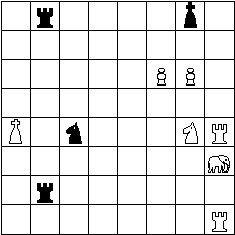Dilaram's problem
In old Arabic manuscripts, written 1001 years ago, there is the story of a nobleman, who had several wives, but one was his most favorite. He called here heart's ease, or Dilaram, because his heart would know no ease without her. One upon a time, he was playing chess with a strong chessplayer, and, as was usual in those time, he played for a stake. When playing, stakes raised and raised, and finally, the nobleman staked Dilaram on the game. Unfortunately, the game went badly for the nobleman, and defeat seamed unavoidable, and finally, the game came to the following position:
 White:
White:
King a4; Rook h1, h4; Elephant h3; Knight g4; Pawn f6; g6 (7 pieces).
Black:
King g8; Rook b2, b8; Knight c4 (4 pieces).
Those unaware of the rules of Shatranj, should know that this was the game of Shatranj, as chess was called in that time - a game, very similar to the game of chess as it is played in our times, but with differences: the game knows elephants, who jump two squares diagonally, and generals, who move one square diagonally.
Now, in the present position, the nobleman, who played the white pieces, was to move, expecting to be mated on his opponents return move.
Dilaram however saw how the happiness of her life could be saved, and shouted to her husband and lover:
If you aren't interested in the story, you can look directly to the solution.
Written by Hans Bodlaender.
WWW page created: August 13, 1996. Last modified: September 9, 1997.